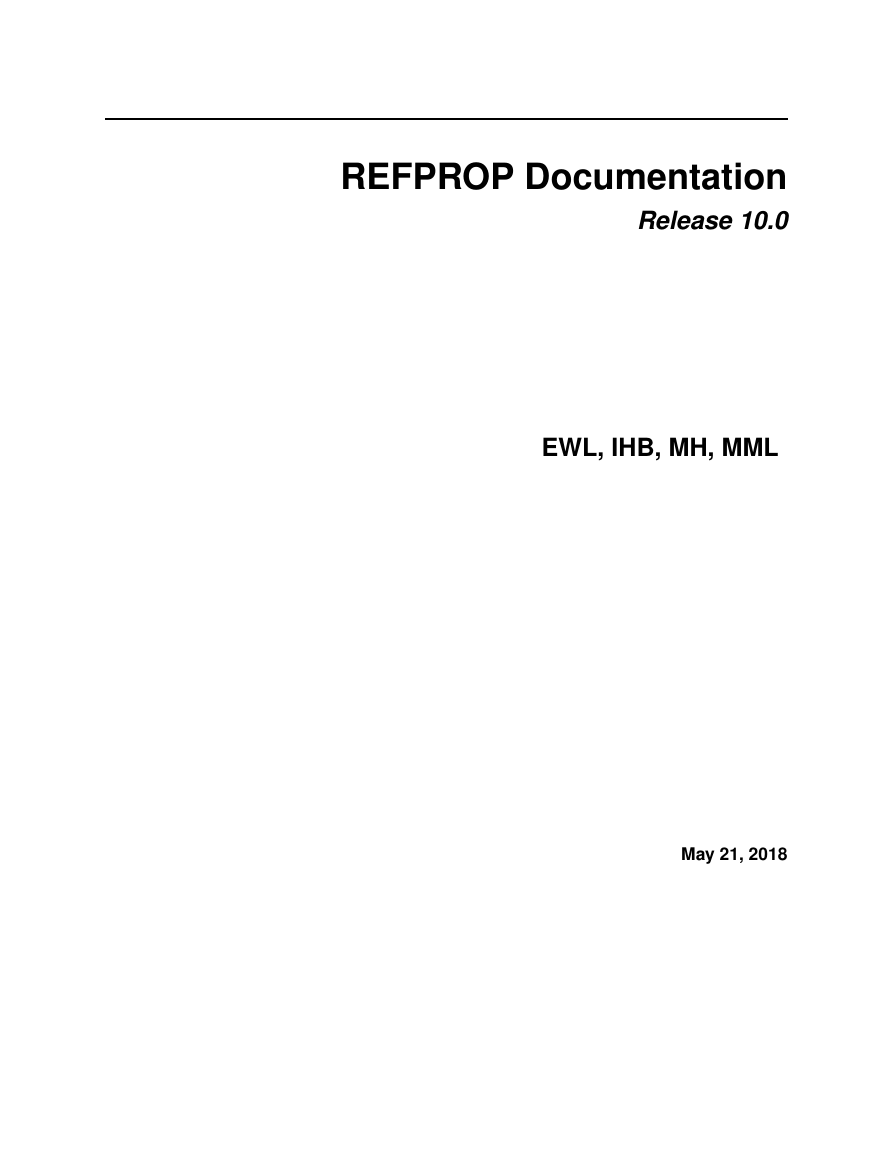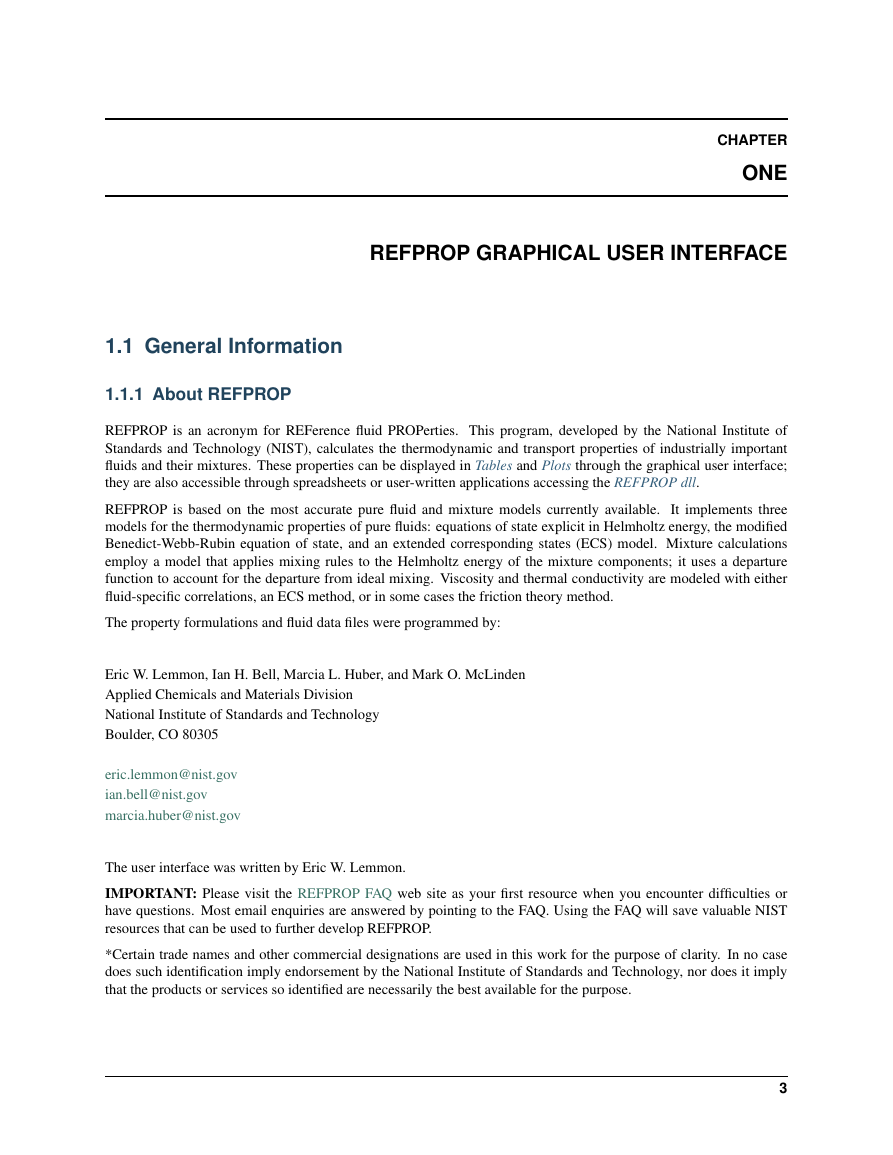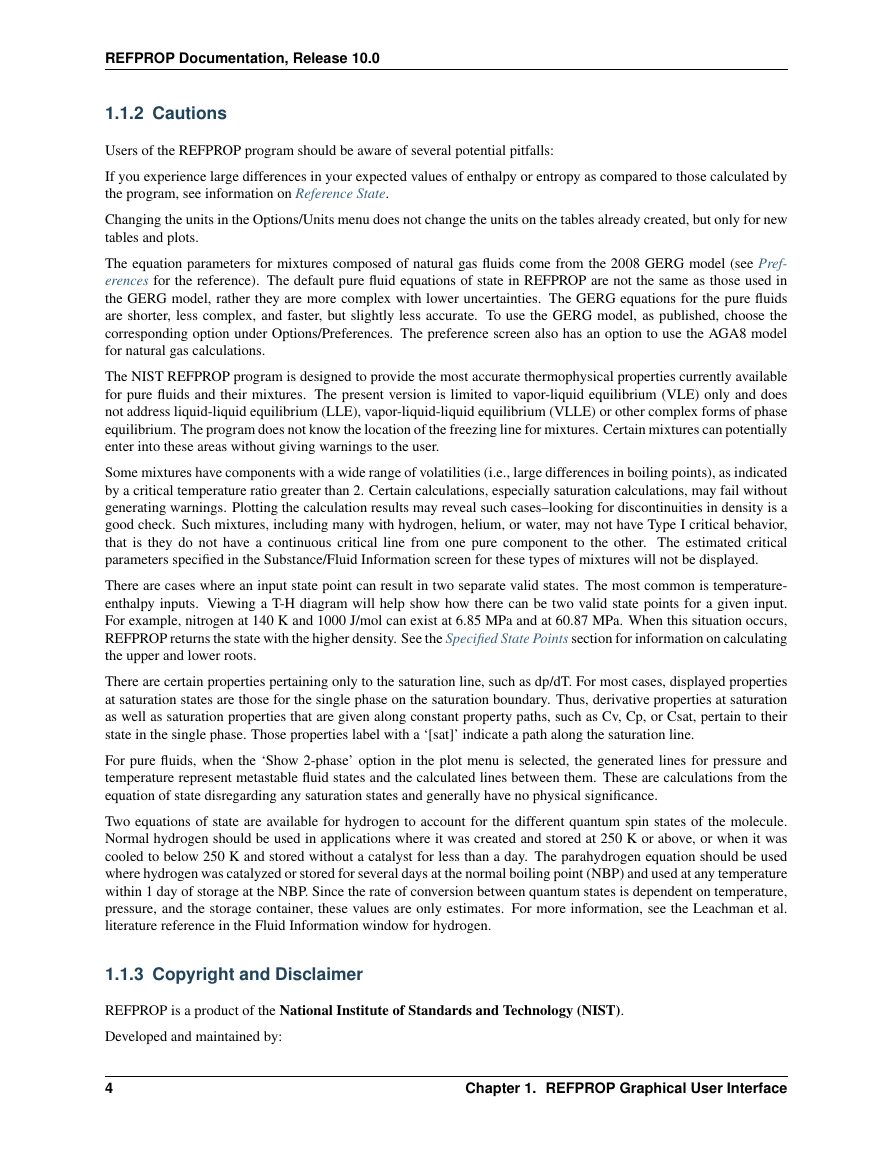REFPROP Documentation
Release 10.0
EWL, IHB, MH, MML
May 21, 2018
�
�
CONTENTS
1 REFPROP Graphical User Interface
.
.
.
1.1 General Information .
.
1.2 Menu Commands .
1.3 DLLs .
.
.
.
.
.
.
.
.
.
.
.
.
.
.
.
.
.
.
.
.
.
. . . . . . . . . . . . . . . . . . . . . . . . . . . . . . . . . . . . .
. . . . . . . . . . . . . . . . . . . . . . . . . . . . . . . . . . . . .
. . . . . . . . . . . . . . . . . . . . . . . . . . . . . . . . . . . . .
2 REFPROP DLL documentation
.
.
2.1 High-Level API
2.2
.
Legacy API .
.
.
.
.
.
.
.
.
.
.
.
.
.
.
.
. . . . . . . . . . . . . . . . . . . . . . . . . . . . . . . . . . . . .
. . . . . . . . . . . . . . . . . . . . . . . . . . . . . . . . . . . . .
3
3
6
26
27
27
55
i
�
ii
�
REFPROP Documentation, Release 10.0
REFPROP is an acronym for REFerence fluid PROPerties. This program, developed by the National Institute of
Standards and Technology (NIST), calculates the thermodynamic and transport properties of industrially important
fluids and their mixtures. These properties can be displayed in Tables and Plots through the graphical user interface;
they are also accessible through spreadsheets or user-written applications accessing the REFPROP dll.
REFPROP is based on the most accurate pure fluid and mixture models currently available.
It implements three
models for the thermodynamic properties of pure fluids: equations of state explicit in Helmholtz energy, the modified
Benedict-Webb-Rubin equation of state, and an extended corresponding states (ECS) model. Mixture calculations
employ a model that applies mixing rules to the Helmholtz energy of the mixture components; it uses a departure
function to account for the departure from ideal mixing. Viscosity and thermal conductivity are modeled with either
fluid-specific correlations, an ECS method, or in some cases the friction theory method.
CONTENTS
1
�
REFPROP Documentation, Release 10.0
2
CONTENTS
�
CHAPTER
ONE
REFPROP GRAPHICAL USER INTERFACE
1.1 General Information
1.1.1 About REFPROP
REFPROP is an acronym for REFerence fluid PROPerties. This program, developed by the National Institute of
Standards and Technology (NIST), calculates the thermodynamic and transport properties of industrially important
fluids and their mixtures. These properties can be displayed in Tables and Plots through the graphical user interface;
they are also accessible through spreadsheets or user-written applications accessing the REFPROP dll.
REFPROP is based on the most accurate pure fluid and mixture models currently available.
It implements three
models for the thermodynamic properties of pure fluids: equations of state explicit in Helmholtz energy, the modified
Benedict-Webb-Rubin equation of state, and an extended corresponding states (ECS) model. Mixture calculations
employ a model that applies mixing rules to the Helmholtz energy of the mixture components; it uses a departure
function to account for the departure from ideal mixing. Viscosity and thermal conductivity are modeled with either
fluid-specific correlations, an ECS method, or in some cases the friction theory method.
The property formulations and fluid data files were programmed by:
Eric W. Lemmon, Ian H. Bell, Marcia L. Huber, and Mark O. McLinden
Applied Chemicals and Materials Division
National Institute of Standards and Technology
Boulder, CO 80305
eric.lemmon@nist.gov
ian.bell@nist.gov
marcia.huber@nist.gov
The user interface was written by Eric W. Lemmon.
IMPORTANT: Please visit the REFPROP FAQ web site as your first resource when you encounter difficulties or
have questions. Most email enquiries are answered by pointing to the FAQ. Using the FAQ will save valuable NIST
resources that can be used to further develop REFPROP.
*Certain trade names and other commercial designations are used in this work for the purpose of clarity. In no case
does such identification imply endorsement by the National Institute of Standards and Technology, nor does it imply
that the products or services so identified are necessarily the best available for the purpose.
3
�
REFPROP Documentation, Release 10.0
1.1.2 Cautions
Users of the REFPROP program should be aware of several potential pitfalls:
If you experience large differences in your expected values of enthalpy or entropy as compared to those calculated by
the program, see information on Reference State.
Changing the units in the Options/Units menu does not change the units on the tables already created, but only for new
tables and plots.
The equation parameters for mixtures composed of natural gas fluids come from the 2008 GERG model (see Pref-
erences for the reference). The default pure fluid equations of state in REFPROP are not the same as those used in
the GERG model, rather they are more complex with lower uncertainties. The GERG equations for the pure fluids
are shorter, less complex, and faster, but slightly less accurate. To use the GERG model, as published, choose the
corresponding option under Options/Preferences. The preference screen also has an option to use the AGA8 model
for natural gas calculations.
The NIST REFPROP program is designed to provide the most accurate thermophysical properties currently available
for pure fluids and their mixtures. The present version is limited to vapor-liquid equilibrium (VLE) only and does
not address liquid-liquid equilibrium (LLE), vapor-liquid-liquid equilibrium (VLLE) or other complex forms of phase
equilibrium. The program does not know the location of the freezing line for mixtures. Certain mixtures can potentially
enter into these areas without giving warnings to the user.
Some mixtures have components with a wide range of volatilities (i.e., large differences in boiling points), as indicated
by a critical temperature ratio greater than 2. Certain calculations, especially saturation calculations, may fail without
generating warnings. Plotting the calculation results may reveal such cases–looking for discontinuities in density is a
good check. Such mixtures, including many with hydrogen, helium, or water, may not have Type I critical behavior,
that is they do not have a continuous critical line from one pure component to the other. The estimated critical
parameters specified in the Substance/Fluid Information screen for these types of mixtures will not be displayed.
There are cases where an input state point can result in two separate valid states. The most common is temperature-
enthalpy inputs. Viewing a T-H diagram will help show how there can be two valid state points for a given input.
For example, nitrogen at 140 K and 1000 J/mol can exist at 6.85 MPa and at 60.87 MPa. When this situation occurs,
REFPROP returns the state with the higher density. See the Specified State Points section for information on calculating
the upper and lower roots.
There are certain properties pertaining only to the saturation line, such as dp/dT. For most cases, displayed properties
at saturation states are those for the single phase on the saturation boundary. Thus, derivative properties at saturation
as well as saturation properties that are given along constant property paths, such as Cv, Cp, or Csat, pertain to their
state in the single phase. Those properties label with a ‘[sat]’ indicate a path along the saturation line.
For pure fluids, when the ‘Show 2-phase’ option in the plot menu is selected, the generated lines for pressure and
temperature represent metastable fluid states and the calculated lines between them. These are calculations from the
equation of state disregarding any saturation states and generally have no physical significance.
Two equations of state are available for hydrogen to account for the different quantum spin states of the molecule.
Normal hydrogen should be used in applications where it was created and stored at 250 K or above, or when it was
cooled to below 250 K and stored without a catalyst for less than a day. The parahydrogen equation should be used
where hydrogen was catalyzed or stored for several days at the normal boiling point (NBP) and used at any temperature
within 1 day of storage at the NBP. Since the rate of conversion between quantum states is dependent on temperature,
pressure, and the storage container, these values are only estimates. For more information, see the Leachman et al.
literature reference in the Fluid Information window for hydrogen.
1.1.3 Copyright and Disclaimer
REFPROP is a product of the National Institute of Standards and Technology (NIST).
Developed and maintained by:
4
Chapter 1. REFPROP Graphical User Interface
�
















 2023年江西萍乡中考道德与法治真题及答案.doc
2023年江西萍乡中考道德与法治真题及答案.doc 2012年重庆南川中考生物真题及答案.doc
2012年重庆南川中考生物真题及答案.doc 2013年江西师范大学地理学综合及文艺理论基础考研真题.doc
2013年江西师范大学地理学综合及文艺理论基础考研真题.doc 2020年四川甘孜小升初语文真题及答案I卷.doc
2020年四川甘孜小升初语文真题及答案I卷.doc 2020年注册岩土工程师专业基础考试真题及答案.doc
2020年注册岩土工程师专业基础考试真题及答案.doc 2023-2024学年福建省厦门市九年级上学期数学月考试题及答案.doc
2023-2024学年福建省厦门市九年级上学期数学月考试题及答案.doc 2021-2022学年辽宁省沈阳市大东区九年级上学期语文期末试题及答案.doc
2021-2022学年辽宁省沈阳市大东区九年级上学期语文期末试题及答案.doc 2022-2023学年北京东城区初三第一学期物理期末试卷及答案.doc
2022-2023学年北京东城区初三第一学期物理期末试卷及答案.doc 2018上半年江西教师资格初中地理学科知识与教学能力真题及答案.doc
2018上半年江西教师资格初中地理学科知识与教学能力真题及答案.doc 2012年河北国家公务员申论考试真题及答案-省级.doc
2012年河北国家公务员申论考试真题及答案-省级.doc 2020-2021学年江苏省扬州市江都区邵樊片九年级上学期数学第一次质量检测试题及答案.doc
2020-2021学年江苏省扬州市江都区邵樊片九年级上学期数学第一次质量检测试题及答案.doc 2022下半年黑龙江教师资格证中学综合素质真题及答案.doc
2022下半年黑龙江教师资格证中学综合素质真题及答案.doc